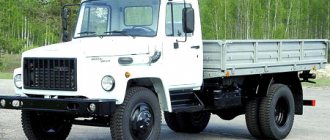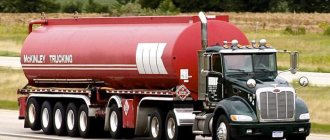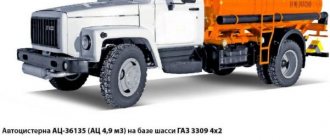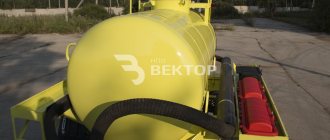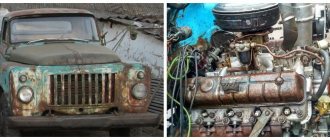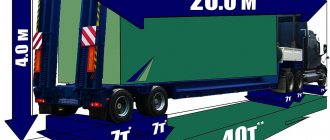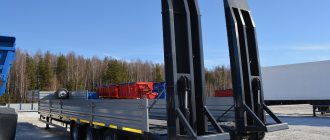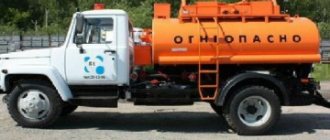GAZ 53 is almost the most popular truck in Russia. Many different special vehicles were created on the chassis of this truck. In particular, the GAZ 53 02 dump truck was produced, and KAVZ 685 buses were assembled on the GAZ 53 40 chassis. Milk and fuel tankers were assembled on the GAZ 53 chassis.
How to iron a GAZ 53 fuel truck
The GAZ 53 fuel tanker has always been in demand, and nowadays there is a special interest in such equipment. Fuel trucks are often bought by private entrepreneurs, since a good business can be built on transporting fuel.
Fuel trucks based on the GAZ 53 are often sold through private advertisements. Prices for equipment can be very different; the cost directly depends on the condition of the car. In a shabby state, a “barrel” costs from 50 thousand rubles, the prices of well-preserved cars with low mileage reach 250 thousand rubles or more.
Select GAZ equipment
We will be happy to help you solve your problems using GAZ equipment. Let's talk about preferential programs.
Send a request
call me back
With a steel one- or two-section tank with a capacity of 5300 liters.
Price from 2,995,000 RUR
With a steel two-section tank with a capacity of 1500 liters.
Price from 1,830,000 ₽
With a steel two-section tank with a capacity of 1500 liters.
Price from 1,585,000 RUR
This is interesting: Truck license - what category is needed for a truck driver
Fuel tanker GAZon Next
The fifth generation GAZon Next truck appeared in 2014. The truck has a modern design and excellent technical characteristics. The car is equipped only with diesel internal combustion engines; gasoline versions are not provided from the factory. There are only two types of internal combustion engines in the range of engines:
- Cummins ISF 3.8L;
- YaMZ-5344 with a volume of 4.43 liters.
On some LAWNs, a pre-heater is installed upon request, ensuring uninterrupted starting of a cold engine in any frost. The new car contains many imported components of excellent quality that extend the service life of the equipment.
GAZon Next fuel tankers are produced with tanks of different volumes and sizes - ATZ-5.2 and ATZ-4.9 are popular.
There is also a mini fuel tanker - it is equipped with a fuel dispenser and a 1500 liter tank.
Design features
Depending on the scope of application, each type of tank truck has its own design features. And they are determined and manufactured in strict accordance with the requirements of GOSTs and approved regulations.
Moreover, not only overall dimensions, load capacity, breakwaters, mechanical strength and axle load are regulated. Particular attention is paid to transportation safety in accordance with ADR (Declaration on the Transport of Dangerous Goods). This is what manufacturers are starting from.
Currently, there are several types of tank sections: in the form of an ellipse, a strict circle, a so-called suitcase (a square or rectangle with rounded edges), as well as a variable section.
Each type of tank section is determined by the main technical characteristics of the base chassis of either a car, a trailer, or a semi-trailer. First of all, parameters such as load capacity, axle load, and frame length are taken into account.
What is the weight of a railway tank?
Weight of a railway tank. How much does a railway tank weigh?
| Model | Load capacity, t | Car tare weight, t |
| 8-axle tank for petroleum products, model 15-871 | 120 | 48,8 |
| 8-axle oil tanker | 125 | 51 |
| 4-axle tank for gasoline and light oil products, model 15-869 | 62 | 23,5 |
Device
Externally, fuel tankers based on the GAZ-53 are distinguished by features characteristic of the brand and specific model - a small cabin with a long hood and protruding fenders, as well as an oval barrel with a pump. These units offer the user a number of possibilities, completely dependent on the technical configuration of the device:
- The installed ZMZ-53 engine (carburetor, 4-stroke, with 8 working cylinders) provides relatively high power for a medium-tonnage truck - 125 hp.
- The gearbox is designed for 5 speeds - 4 forward gears and one reverse.
- The chassis is represented by 2 axles with a 4*2 wheel formula and a dependent leaf spring suspension, equipped with telescopic shock absorbers to give the vehicle a smoother ride.
- Transmission mechanism – mechanical 4-speed.
- The steering is without power steering, which somewhat complicates control, but greatly simplifies the design.
- The brake system is drum type.
- The tank (barrel) is oval-shaped, welded from high-strength sheet steel, horizontally located, having internal stiffeners to increase its strength and safety of use (breakwaters prevent damage to the barrel due to both external mechanical influences and internal water hammer).
- The pump with which the tank is equipped is of a vane centrifugal type and is driven to the truck engine through the PTO.
Dimensions of the GAZ-53 fuel truck
Specifications
Technical characteristics of the GAZ-53 fuel tanker:
| Characteristics | Indicators |
| Weight, kg: | |
| - common for the entire unit | 7157 |
| - base chassis | 3470 |
| Dimensions, mm: | |
| - length | 6190 |
| - width | 2380 |
| - height | 2590 |
| Vehicle base length, mm | 3700 |
| Ground clearance, mm | 245-265 |
| Engine parameters, hp, brand / power | ZMZ-53/125 |
| Engine volumes, cm3 | 4254 |
| Fuel consumption per 100 km, l | 25-28 |
| Speed max., km/h | 85 |
| Tank brand | 806 (ATs-4.2-53A), 808 (ATs-4.2-53A) |
| Capacity (volume) of the barrel, l | 4200-4800 |
| Maximum permissible density of transported petroleum products, g/cm3 | 0,86 |
Video review of the GAZ-53 fuel truck:
Fuel truck LAWN | Tanker | ATZ
Information for choosing the right tanker:
Tankers for transporting food liquids are divided according to their purpose, according to the name of the liquid for which they are designed:
| Milk tanker | transports liquid dairy products |
| Water carrier | transports mineral, fresh, sea water |
| Oil truck | transports vegetable and sunflower oil |
| Alcohol truck | transports alcoholic liquids, drinks, alcohol * |
* Special production and design requirements apply to the technical characteristics of the alcohol tank. All modern tanks that transport perishable liquid cargo are made of stainless steel, since its use is due to its unique properties. Stainless steel does not react chemically with transported liquids and does not oxidize. To achieve maximum shelf life without compromising product quality, the tanks have thermal insulation properties and are able to transport cargo at temperatures up to “+35°C” without changing the internal temperature of the liquid. In addition to heat-insulating materials, in conditions of low temperatures in cold climates, tanks are also equipped with special heating. In the production process of food tanks, only high-quality materials are used that meet all safety standards.
Tankers are divided according to the volume of transported products, liters:
| 1000 | 9500 |
| 1200 | 16000 |
| 3900 | 19000 |
| 4200 | 24000 |
| 7500 | More than 24000 |
They are classified according to the type of tank installation:
| Trailer |
| Semitrailer |
| Based on a car chassis |
Basic components, depending on the type and class of the tank:
| Tank liquid level sensor |
| Suction and delivery hoses |
| Flow meters |
| Special shut-off valves for hatches. |
| Drain pump | pouring liquid through hatches |
| Drain tap |
| And others, the installation of which is prescribed in the technical specifications for the manufacture of a tank truck. |
Moreover, the container can be divided into several compartments and simultaneously transport several different types of liquid at once. Our company offers to install a tank on the chassis of a GAZ 3309 car for transportation of food and liquid products. Our company’s engineers have extensive experience in designing tanks that are of very high quality, wear resistance and meet all safety requirements imposed on them. Moreover, the tank installed on the chassis of the GAZ 3309 allows you to transport up to 5000 liters of cargo, and given the relative compactness of this truck, it makes it as maneuverable as possible, which allows you to freely transport milk, water and other food liquids along city roads. Our specialists have already successfully designed and developed tank trucks for the largest dairy plants in Russia, including the Murmansk region. Water carriers were supplied to leading municipal utilities in the region. Moreover, water carriers are a competent solution for delivering food water to the location of workers and shift crews who are located in hard-to-reach places without water pipes and other utility systems.
What is a machine
At construction sites, public utilities, commercial structures and private buildings, there is a need to remove wastewater from collection points or eliminate flooding of structures. Since 1964, at the production base of the Gorky Automobile Plant, the GAZ 53 special vehicle has been produced for these purposes, on which a waste collection tank is installed.
Vacuum truck GAZ 53
The car has good stability and controllability, it is reliable, which is confirmed by the low probability of component failure. The machine is characterized by ease of operation, sufficient tank volume, optimal fuel consumption and good maintainability with low cost of spare parts.
Attachments are installed on the base of a serial truck to carry out the work process. The most important part for the work, which is equipped with a special machine, is a sealed technological tank made of thick steel with a hatch for liquid supply.
Special equipment equipment
The equipment of the GAZ 53 vacuum truck consists of:
Pump diagram KO-503
- vacuum pump to create excess pressure (brand KO-503);
- alarm and safety device to stop the pump when the tank is full;
- a structural hose with which the tank is filled;
- control mechanisms;
- electronics.
For the installation of pumps and blowing equipment, which is equipped with the GAZ 53 sewage disposal truck, a place was chosen between the cabin and the tank, as well as the lower part of the truck. The tank is usually painted red or orange.
The car is controlled from the cockpit, where all control sensors are located. The machine can be operated at temperatures from -20 to +40 degrees. The travel speed of a loaded GAZ 53 sewer truck reaches 80 km/h. The tank is unloaded in approximately 2 - 4 minutes.
Tank trucks GAZ 51
The first tank trucks were an iron tank, which was mounted on a frame made of beams and secured with clamps. The barrel for transporting liquid fuel included special fittings, consisting of a cleaning filter and a safety valve that relieved excess pressure of gasoline or kerosene vapors. Two shut-off valves were installed at the bottom of the barrel; with the help of them, fuel was drained from the tank by gravity through flexible hoses.
Tank truck based on GAZ 51 for transportation of petroleum products
The ABB-2 tank served to transport drinking water, the ATsPT-1.8 model delivered milk, and the equipment served to transport vegetable oil, live fish, and beer. The last numbers in the name of the special vehicles indicated the capacity of the barrel - for example, for a milk tanker it is 1.8 m³. It was much more profitable to transport milk in a barrel than in flasks:
- You can transport a large volume at once;
- The product did not sour for a long time, since the tank was isothermal and the milk did not heat up in it.
More than one modification of fire engines was assembled on the basis of the GAZ 51 - there were several vehicles. The most common models were PMG-6 and PMG-12.
